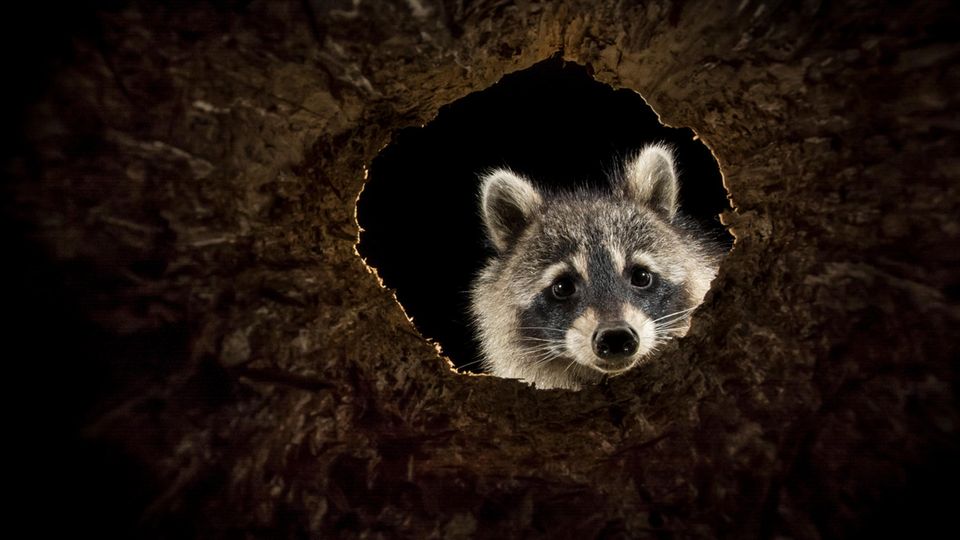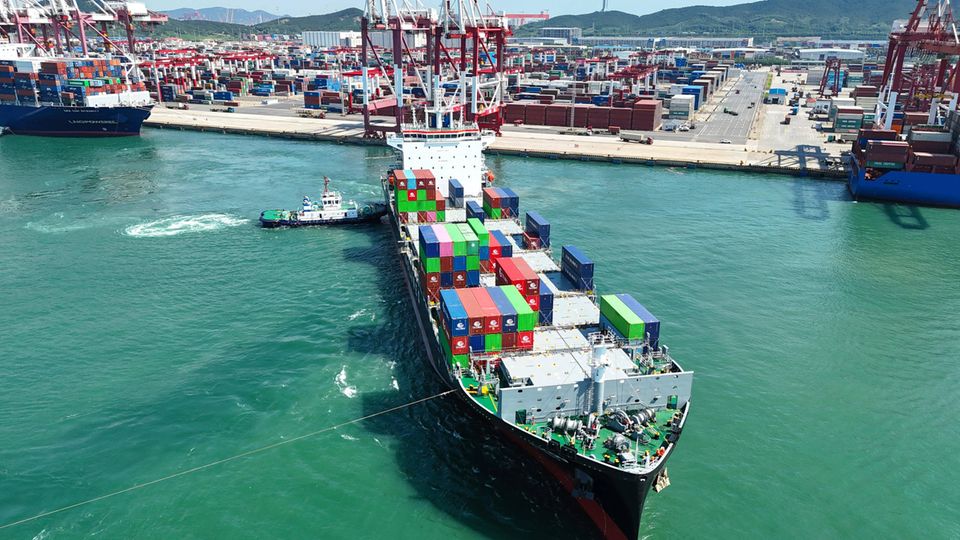Invasive species
90 years ago, four raccoons were released in Hesse – the starting signal for the conquest of an entire continent
A raccoon sits in a tree in the Edersee Wildlife Park. Since two pairs of raccoons were released at Edersee in northern Hesse 90 years ago, the animals have spread enormously across the country.
© Uwe Zucchi / dpa
Since two pairs of raccoons were released in northern Hesse 90 years ago, the animals have spread enormously across the country. According to experts, they are a threat to the diversity of native species.
At night the trash can lids rattle, and the next morning there is rubbish scattered all over the street. When looking for food, raccoons are not exactly considerate and picky, but they are more skilled and adaptable. This is now a problem given the massive spread of animals in Germany. Because the omnivores with the characteristic Zorro mask not only disturb the night’s sleep in residential areas, but according to experts they also threaten the existence of some local animal species.
“Raccoons always eat what there is most of,” says wildlife biologist Norbert Peter from the University of Frankfurt. Together with other experts, he is investigating the hunting behavior of raccoons in selected nature reserves as part of the Zowiac joint project (zoonotic and wildlife ecological effects of invasive carnivores). . In spring, for example, these are amphibians that are on their way to their spawning grounds to lay their eggs there. The raccoon specifically selects them as a food resource. “This can have an impact on endangered species.”
An estimated two million raccoons in Germany
According to Peter, the crepuscular and nocturnal raccoon now has an estimated two million individuals nationwide, and the trend is rising. The release of two pairs of raccoons on April 12, 1934 at the Edersee in northern Hesse is considered to be the most important event in Europe for the spread of the predator, which originally came from North America. In 1945, after a bomb hit a fur farm near Strausberg in Brandenburg during the Second World War, some animals fled. Since then, without any natural enemies, they have been able to spread almost unhindered. Since 2016 they have been listed on the so-called Union list, which contains invasive species in the EU.
Invasive species
With tanks, super slime and a “Zorro” mask – these are Germany’s animal immigrants
“Raccoons can now be found in almost all of Germany,” says Torsten Reinwald, press spokesman and deputy managing director of the German Hunting Association (DJV). The animals are particularly widespread in northern Hesse, southern Lower Saxony and Brandenburg. They can be hunted all year round in almost all federal states, subject to maternal animal protection According to DJV statistics, 202,821 raccoons were officially killed nationwide in the 2022/23 hunting year, compared to 9,064 in the 2000/01 season.
The animals, which belong to the small bear family, are extremely adaptable and intelligent and can climb and swim very well, explains Reinwald. “So they can occupy a lot of ecological niches and challenge other species’ habitat or eat them.” In Thuringia, for example, raccoons now occupy half of all potential nesting places for eagle owls and drive the birds away. In Brandenburg there are a large number of strictly protected European pond turtles Mutilations occur. “The raccoons eat their limbs and plunder their clutches.” They also patrolled toad protection fences and ate the amphibians from the buckets.
Poisonous skin from toads is peeled off
In order to shed more light on the hunting behavior of raccoons, wildlife biologist Peter and his team collected data in nature reserves in Hesse as well as in Brandenburg and Saxony-Anhalt. The scientists discovered that raccoons are also predators of strictly protected common toads, yellow-bellied toads and their spawn. Their toxic skin doesn’t stop them. “The raccoons skin them before they eat them. This is shown by many of the victims’ finds,” reports Peter.
Raccoons would have a negative impact on amphibian populations, especially in isolated spawning waters. “We see predation pressure on protected amphibians and reptiles in certain areas, which is sometimes threatening the existence of these species,” says Peter. According to him, the researchers often found the remains of grass snakes in the stomach contents of the raccoons. Genetic evidence has been used in the Rheingau-Taunus study area -Circle, a specimen of the highly endangered Aesculapian snake that was eaten while laying eggs can also be identified.
“The raccoon is a cute and cuddly animal, but you must not forget that it is a predator,” says Julian Heiermann from the German Nature Conservation Association (NABU).
Many amphibian species already have massive problems with reproduction, for example due to the application of pesticides and fertilizers, the fragmentation of habitats due to traffic routes and the advancing climate change and the associated droughts in which spawning waters repeatedly dry out. “And then there’s a predator like the raccoon on top of that.”
Hunting is controversial as an effective means
So how do you deal with these cute pests? “We can’t get rid of the raccoons,” says Reinwald. “But with hunting we can significantly reduce the population. There is no more effective measure.” Hunting is essential, but this is not allowed in Berlin, for example. “Almost 40 percent of animals are caught in live traps.” Politicians must commit to hunting as a species protection tool, he demands.
Nabu, however, is critical of hunting or catching raccoons. Increased trapping is not an effective way to alleviate the problem, says Heiermann. “Theoretically, it would be possible to contain the population this way. In practice, it’s too complicated. You can’t set up that many traps to reduce the raccoon population over a large area.” In addition, corresponding measures have been unsuccessful in the past: “The raccoon has been around forever Hunted, but it has continued to spread happily.” Sterilization and castration of animals are also not a solution, nor is medication-based contraception. “These are nice ideas, but they are too complex to be practical.”
Nabu doesn’t have a model solution either. “From our point of view, the question is how we can help the local populations. To do this, we have to strengthen their habitat. Then they can reproduce better and compensate for losses better.” The animals needed protected and diverse habitats in which to feed themselves to be able to hide and reproduce. “Amphibians, for example, need more bodies of water and more natural bank areas with hiding places. The raccoon will still visit them, but it won’t be as easy for him to grab them.”



